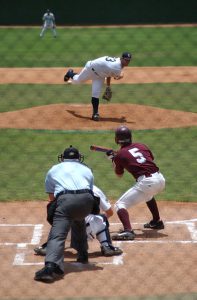In baseball, there’s a strategy known as “small ball”. It’s the idea of deliberate movement from base to base, essentially. Get a runner on first (maybe with a walk), bunt the runner over to second, then get the runner home with a single to right field. Instead of depending on monster hitters and big innings and lots of home runs, the idea is to score through an intentional, step by step approach to moving runners around the bases. Stealing bases, bunting, working the pitcher for a walk – they’re about to become dinosaurs in modern baseball, but they have their place and they can be an effective strategy for winning.
This article in Inside Higher Ed talks about “small teaching” and it’s very much like small ball – intentionality around small changes or step-by-step progress. I missed James Lang’s Small Teaching: Everyday Lessons from the Science of Learning when it first came out – although it’s now in my Amazon shopping cart. But now there’s a book out by Flower Darby called Small Teaching Online, extending the principles to the online teaching environment (which I where I still occasionally teach).
The basic idea, as we learn from the article in Inside Higher Ed (or from this series of articles in The Chronicle of Higher Education), is that we can use the science of learning to make small, intentional, incremental changes in our teaching that will have a big impact on student learning. I don’t know about you, but I could do a better job of keeping up with the science of learning. In the meantime, I can learn more about Small Teaching, where I find suggestions like making a small change to how a class starts (or ends) that can bear significant fruit. I’ve read about Classroom Assessment Techniques (CATs) for twenty years – such things as the minute paper at the end of class, for instance (answering these two questions: “What was the more important thing you learned today? What questions do you still have?”). Small teaching is right in line with those CATs from twenty years ago.
Here’s an excerpt from Professor Lang:
“For example, we have excellent evidence that students remember material better when they test themselves and try to retrieve information from their own minds. And yet most students still study by reviewing their notes over and over again — probably the least-effective study strategy they can employ. The final five minutes of class can provide a quick opportunity to let students know how best to prepare for their next assessment, based on the science of learning and on your experience as an expert learner.
Before the midterm, I asked students to take two minutes and write down for me how they studied for the test. When I compared what they said with the exam scores, the evidence couldn’t have been clearer: Low-performing students used phrases like “reviewed my notes” and “reread the poems”; the students who aced the exam said things like “wrote an outline,” “rewrote my notes,” “organized a timeline,” “tested myself,” and “created flashcards.” I made a slide with a side-by-side comparison of the two columns, and spent five minutes of class showing students the differences. They’ll see that slide again in the last five minutes of class just before the next exam.
Imagine what a difference we could make if we all took five minutes — even just a few times during the semester — to offer students the opportunity to reflect on their learning habits. We could inform their choices with some simple research, and inspire them to make a change. One five-minute session in one course might not mean much, but dozens of such sessions across a student’s college education would add up.”
Just like small ball can be successful, small changes to our teaching can help students learn more successfully. I encourage you to investigate – and remember the power of the bunt for moving runners along!

Image by Keith Johnston from Pixabay
